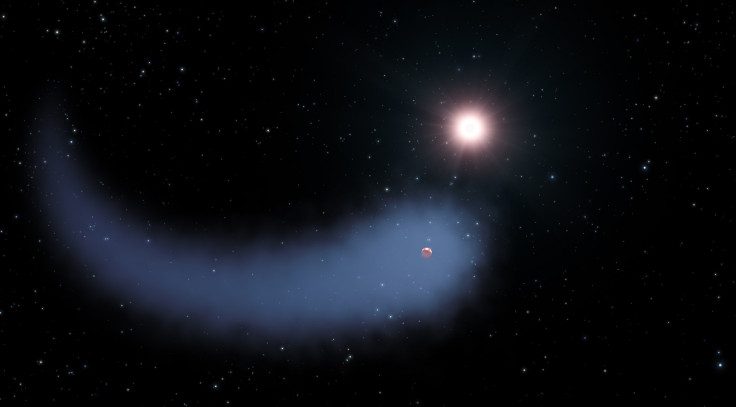NASA's Hubble Spots Neptune-Sized Planet With A Gigantic 'Comet-Like' Tail

GJ 436b is a planet but does not look like one. The Neptune-sized planet, located just 30 light-years from Earth and observed using NASA’s Hubble Space Telescope, has a gigantic tail of hydrogen -- nearly 50 times the size of its parent star.
The presence of the hydrogen tail, which is seen bleeding off from its atmosphere due to extreme radiation from the star, makes it look more like a comet. “This cloud is very spectacular, though the evaporation rate does not threaten the planet right now,” David Ehrenreich from the Observatory of the University of Geneva in Switzerland, said, in a statement released Wednesday.
“But we know that in the past, the star, which is a faint red dwarf, was more active. This means that the planet evaporated faster during its first billion years of existence because of the strong radiation from the young star. Overall, we estimate that it may have lost up to 10 percent of its atmosphere over the past several billion years.”
The detection of the hydrogen cloud -- dubbed “the Behemoth” -- is the first of its kind and could help scientists understand how planets with hydrogen-enveloped atmospheres, that are now small, hot, and rocky, might have evolved over billions of years.
GJ 436b, for instance, is located at a distance of less than 2 million miles from its parent star, which is much closer than Mercury is to our sun. Scientists believe that the tail -- over nine million miles in length -- was created because its atmosphere was not heated rapidly enough by the relatively cool red dwarf star, allowing the cloud to stick around and trail behind.
“Evaporation such as this may have happened in the earlier stages of our own solar system, when the Earth had a hydrogen-rich atmosphere that dissipated over 100 to 500 million years,” NASA said, in the statement. “If so, the Earth may previously have sported a comet-like tail.”
The discovery suggests that the so-called “hot super-Earths” -- hot, rocky planets roughly the size of Earth -- could be the remnants of more massive planets that lost their thick, gaseous atmospheres through a similar process.
“Finding ‘the Behemoth’ could be a game-changer for characterizing atmospheres of the whole population of Neptune-sized planets and Super-Earths in ultraviolet observations,” NASA said, in the statement. Moreover, the detection of hydrogen evaporating from a planet, albeit not one as massive and hot as GJ 436b, could signal the presence of an ocean on the surface.
© Copyright IBTimes 2024. All rights reserved.





















